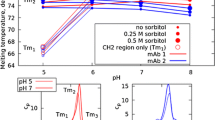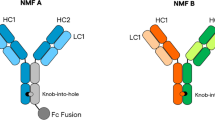Abstract
Purpose
To investigate antibody stability and formation of modified species under upstream processing conditions.
Methods
The stability of 11 purified monoclonal human IgG1 and IgG4 antibodies, including an IgG1-based bispecific CrossMab, was compared in downscale mixing stress models. One of these molecules was further evaluated in realistic bioreactor stress models and in cell culture fermentations. Analytical techniques include size exclusion chromatography (SEC), turbidity measurements, cation exchange chromatography (cIEX), dynamic light scattering (DLS) and differential scanning calorimetry (DSC).
Results
Sensitivity in downscale stress models varies among antibodies and results in formation of high molecular weight (HMW) aggregates. Stability is increased in cell culture medium and in bioreactors. Media components stabilizing the proteins were identified. Extensive chemical modifications were detected both in stress models as well as during production of antibodies in cell culture fermentations.
Conclusions
Protective compounds must be present in chemically defined fermentation media in order to stabilize antibodies against the formation of HMW aggregates. An increase in chemical modifications is detectable in bioreactor stress models and over the course of cell culture fermentations; this increase is dependent on the expression rate, pH, temperature and fermentation time. Consequently, product heterogeneity increases during upstream processing, and this compromises the product quality.





Similar content being viewed by others
Abbreviations
- Tagg :
-
aggregation temperature
- cIEX:
-
cation exchange chromatography
- DSC:
-
differential scanning calorimetry
- DSP:
-
downstream processing
- DLS:
-
dynamic light scattering
- F-Buffer:
-
fermentation-like buffer
- HMW:
-
high molecular weight
- Tm :
-
melting point temperature
- MAb:
-
monoclonal antibody
- NTU:
-
nephelometric turbidity units
- Re:
-
Reynold’s number
- SEC:
-
size exclusion chromatography
- USP:
-
upstream processing
- CHO:
-
chinese Hamster Ovary
- IgG:
-
Immunoglobulin G
- xMAB:
-
CrossMab
- PTFE:
-
polytetrafluoroethylene
- PVDF:
-
polyvinylidenefluoride
- UV:
-
ultraviolet
- PBS:
-
phosphate-buffered saline
References
Carter PJ. Potent antibody therapeutics by design. Nat Rev Immunol. 2006;6:343–57.
Schaefer W, Regula JT, Bähner M, Schanzer J, Croasdale R, Dürr H, Gassner C, Georges G, Kettenberger H, Imhof-Jung S, Schwaiger M, Stubenrauch KG, Sustmann C, Thomas M, Scheuer W, Klein C. Immunoglobulin domain crossover as a generic approach for the production of bispecific IgG antibodies. Proc Natl Acad Sci USA. 2011;108(27):11187–92.
Cromwell MEM, Hilario E, Jacobson F. Protein aggregation and bioprocessing. AAPS J. 2006;8:E572–9.
Vazquez-Rey M, Lang DA. Aggregates in monoclonal antibody manufacturing processes. Biotechnol Bioeng. 2011;108:1494–508.
Schroder M, Schafer R, Schafer R, Friedl P. Induction of protein aggregation in an early secretory compartment by elevation of expression level. Biotechnol Bioeng. 2002;78:131–40.
Zhang YB, Howitt J, McCorkle S, Lawrence P, Springer K, Freimuth P. Protein aggregation during overexpression limited by peptide extensions with large net negative charge. Protein Expr Purif. 2004;36:207–16.
Nakanishi K, Sakiyama T, Imamura K. On the adsorption of proteins on solid surfaces, a common but very complicated phenomenon. J Biosci Bioeng. 2001;91:233–44.
Franco R, Daniela G, Fabrizio M, Ilaria G, Detlev H. Influence of osmolarity and pH increase to achieve a reduction of monoclonal antibodies aggregates in a production process. Cytotechnology. 1999;29:11–25.
Arosio P, Barolo G, Muller-Spath T, Wu H, Morbidelli M. Aggregation stability of a monoclonal antibody during downstream processing. Pharm Res. 2011;28:1884–94.
Biddlecombe JG, Craig AV, Zhang H, Uddin S, Mulot S, Fish BC, Bracewell DG. Determining antibody stability: creation of solid–liquid interfacial effects within a high shear environment. Biotechnol Prog. 2007;23:1218–22.
Wang W, Singh S, Zeng DL, King K, Nema S. Antibody structure, instability, and formulation. J Pharm Sci. 2007;96:1–26.
Rosenberg AS. Effects of protein aggregates: an immunologic perspective. AAPS J. 2006;8:E501–7.
Vazquez E, Corchero JL, Villaverde A. Post-production protein stability: trouble beyond the cell factory. Microb Cell Fact. 2011;10:10–60.
Gomez N, Subramanian J, Ouyang J, Nguyen MD, Hutchinson M, Sharma VK, Lin AA, Yuk IH. Culture temperature modulates aggregation of recombinant antibody in cho cells. Biotechnol Bioeng (2011).
Quan C, Alcala E, Petkovska I, Matthews D, Canova-Davis E, Taticek R, Ma S. A study in glycation of a therapeutic recombinant humanized monoclonal antibody: where it is, how it got there, and how it affects charge-based behavior. Anal Biochem. 2008;373:179–91.
Li S, Schoneich C, Borchardt RT. Chemical instability of protein pharmaceuticals: mechanisms of oxidation and strategies for stabilization. Biotechnol Bioeng. 1995;48:490–500.
Liu H, Gaza-Bulseco G, Faldu D, Chumsae C, Sun J. Heterogeneity of monoclonal antibodies. J Pharm Sci. 2008;97:2426–47.
Geiger T, Clarke S. Deamidation, isomerization, and racemization at asparaginyl and aspartyl residues in peptides. Succinimide-linked reactions that contribute to protein degradation. J Biol Chem. 1987;262:785–94.
Kim JY, Lee GM. CHO cells in biotechnology for production of recombinant proteins: current state and further potential. Appl Microbiol Biotechnol. 2012;93(3):917–30.
Becker E, Florin L, Pfizenmaier K, Kaufmann H. An XBP-1 dependent bottle-neck in production of IgG subtype antibodies in chemically defined serum-free Chinese hamster ovary (CHO) fed-batch processes. J Biotechnol. 2008;135:217–23.
Kiese S, Papppenberger A, Friess W, Mahler HC. Shaken, not stirred: mechanical stress testing of an IgG1 antibody. J Pharm Sci. 2008;97:4347–66.
Ridgway JB, Presta LG, Carter P. ‘Knobs-into-holes’ engineering of antibody CH3 domains for heavy chain heterodimerization. Protein Eng. 1996;9:617–21.
Mahler HC, Muller R, Friess W, Delille A, Matheus S. Induction and analysis of aggregates in a liquid IgG1-antibody formulation. Eur J Pharm Biopharm. 2005;59:407–17.
Pace CN, Vajdos F, Fee L, Grimsley G, Gray T. How to measure and predict the molar absorption coefficient of a protein. Protein Sci. 1995;4:2411–23.
Maa YF, Hsu CC. Protein denaturation by combined effect of shear and air-liquid interface. Biotechnol Bioeng. 1997;54:503–12.
Thomas CR, Geer D. Effects of shear on proteins in solution. Biotechnol Lett. 2011;33:443–56.
Ishikawa T, Kobayashi N, Osawa C, Sawa E, Wakamatsu K. Prevention of stirring-induced microparticle formation in monoclonal antibody solutions. Biol Pharm Bull. 2010;33:1043–6.
Heads JT, Adams R, D’Hooghe LE, Page MJT, Humphreys DP, Popplewell AG, Henry AJ. Relative stabilities of IgG1 and IgG4 Fab domains: influence of the light-heavy interchain disulfide bond architecture. Protein Sci. 2012;21:1315–22.
Ionescu RM, Vlasak J, Price C, Kirchmeier M. Contribution of variable domains to the stability of humanized IgG1 monoclonal antibodies. J Pharm Sci. 2008;97:1414–26.
Li F, Vijayasankaran N, Shen AY, Kiss R, Amanullah A. Cell culture processes for monoclonal antibody production. MAbs. 2010;2:466–79.
Chou DK, Krishnamurthy R, Randolph TW, Carpenter JF, Manning MC. Effects of Tween 20 and Tween 80 on the stability of Albutropin during agitation. J Pharm Sci. 2005;94:1368–81.
Bam NB, Cleland JL, Yang J, Manning MC, Carpenter JF, Kelley RF, Randolph TW. Tween protects recombinant human growth hormone against agitation-induced damage via hydrophobic interactions. J Pharm Sci. 1998;87:1554–9.
Bahrami A, Shojaosadati SA, Khalilzadeh R, Mohammadian J, Farahani EV, Masoumian MR. Prevention of human granulocyte colony-stimulating factor protein aggregation in recombinant Pichia pastoris fed-batch fermentation using additives. Biotechnol Appl Biochem. 2009;52:141–8.
Chisti Y. Animal-cell damage in sparged bioreactors. Trends Biotechnol. 2000;18:420–32.
Clincke MF, Guedon E, Yen FT, Ogier V, Roitel O, Goergen JL. Effect of surfactant pluronic F-68 on CHO cell growth, metabolism, production, and glycosylation of human recombinant IFN-gamma in mild operating conditions. Biotechnol Prog. 2011;27:181–90.
Gigout A, Buschmann MD, Jolicoeur M. The fate of Pluronic F-68 in chondrocytes and CHO cells. Biotechnol Bioeng. 2008;100:975–87.
Vlasak J, Ionescu R. Heterogeneity of monoclonal antibodies revealed by charge-sensitive methods. Curr Pharm Biotechnol. 2008;9:468–81.
Zheng JY, Janis LJ. Influence of pH, buffer species, and storage temperature on physicochemical stability of a humanized monoclonal antibody LA298. Int J Pharm. 2006;308:46–51.
Vermeer AW, Norde W. The thermal stability of immunoglobulin: unfolding and aggregation of a multi-domain protein. Biophys J. 2000;78:394–404.
Wang W, Nema S, Teagarden D. Protein aggregation–pathways and influencing factors. Int J Pharm. 2010;390:89–99.
Schaefer JV, Pluckthun A. Engineering aggregation resistance in IgG by two independent mechanisms: lessons from comparison of Pichia pastoris and mammalian cell expression. J Mol Biol. 2012;417:309–35.
King AC, Woods M, Liu W, Lu Z, Gill D, Krebs MR. High-throughput measurement, correlation analysis, and machine-learning predictions for pH and thermal stabilities of Pfizer-generated antibodies. Protein Sci. 2011;20:1546–57.
Abbas SA, Sharma VK, Patapoff TW, Kalonia DS. Opposite effects of polyols on antibody aggregation: thermal versus mechanical stresses. Pharm Res. 2012;29:683–94.
Cartaya OA. Serum-free cell culture media. United States Patent 4,205,126, 1980.
Wang W. Instability, stabilization, and formulation of liquid protein pharmaceuticals. Int J Pharm. 1999;185:129–88.
Randolph TW, Jones LS. Surfactant-protein interactions. Pharm Biotechnol. 2002;13:159–75.
van der Pol L, Tramper J. Shear sensitivity of animal cells from a culture-medium perspective. Trends Biotechnol. 1998;16:323–8.
Manning MC, Chou DK, Murphy BM, Payne RW, Katayama DS. Stability of protein pharmaceuticals: an update. Pharm Res. 2010;27:544–75.
Gandhi S, Ren D, Xiao G, Bondarenko P, Sloey C, Ricci MS, Krishnan S. Elucidation of degradants in acidic peak of cation exchange chromatography in an IgG1 monoclonal antibody formed on long-term storage in a liquid formulation. Pharm Res. 2012;29:209–24.
Harris RJ, Kabakoff B, Macchi FD, Shen FJ, Kwong M, Andya JD, Shire SJ, Bjork N, Totpal K, Chen AB. Identification of multiple sources of charge heterogeneity in a recombinant antibody. J Chromatogr B Biomed Sci Appl. 2001;752:233–45.
Patel K, Borchardt RT. Chemical pathways of peptide degradation. II. Kinetics of deamidation of an asparaginyl residue in a model hexapeptide. Pharm Res. 1990;7:703–11.
Kaneko Y, Sato R, Aoyagi H. Changes in the quality of antibodies produced by Chinese hamster ovary cells during the death phase of cell culture. J Biosci Bioeng. 2010;109:281–7.
Huang L, Lu J, Wroblewski VJ, Beals JM, Riggin RM. In vivo deamidation characterization of monoclonal antibody by LC/MS/MS. Anal Chem. 2005;77:1432–9.
Liu YD, van Enk JZ, Flynn GC. Human antibody Fc deamidation in vivo. Biologicals. 2009;37:313–22.
Acknowledgments and Disclosures
We would like to thank Carolin Lucia and Katharina Didzus from Roche Penzberg for their support with bioreactor stress experiments, Sabrina Mahlack for her support with MAb4.2 purification, and Hubert Kettenberger, Holger Kley and Xaver Reiser for their support with DLS and DSC measurements. We would also like to thank Alexandra Schindl for carrying out the shaking stress experiments and Robert Puskeiler for support with calculations of physical parameters of the stirring stress models.
We are also grateful to Jörg Hörnschemeyer and Jonas Fast of Roche Basel for sharing information about the identity of cIEX peaks.
S.D, F.H. F.L. O.P. and K.L are all employees of Roche at the time of publication. The remaining authors declare no competing financial interests.
Author information
Authors and Affiliations
Corresponding author
Rights and permissions
About this article
Cite this article
Dengl, S., Wehmer, M., Hesse, F. et al. Aggregation and Chemical Modification of Monoclonal Antibodies under Upstream Processing Conditions. Pharm Res 30, 1380–1399 (2013). https://doi.org/10.1007/s11095-013-0977-8
Received:
Accepted:
Published:
Issue Date:
DOI: https://doi.org/10.1007/s11095-013-0977-8




